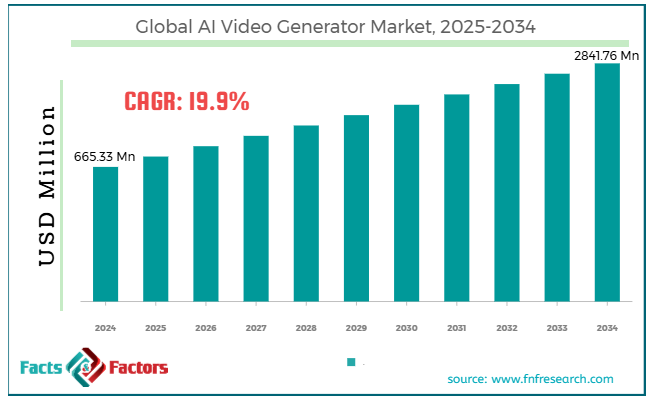Search Market Research Report
AI Video Generator Market Size, Share Global Analysis Report, 2025 – 2034

AI Video Generator Market Size, Share, Growth Analysis Report By Component (Software, Service, and Others), By Deployment Mode (Cloud-based, On-Premises, and Others), By Application (Content Creation, Video Editing, Advertising), And By Region - Global Industry Insights, Overview, Comprehensive Analysis, Trends, Statistical Research, Market Intelligence, Historical Data and Forecast 2025 – 2034
Industry Insights
[221+ Pages Report] According to Facts & Factors, the global AI video generator market size was worth around USD 665.33 million in 2024 and is predicted to grow to around USD 2841.76 million by 2034, with a compound annual growth rate (CAGR) of roughly 19.9% between 2025 and 2034.

 Market Overview
Market Overview
An AI video generator is a software or tool that uses artificial intelligence to create videos automatically from images, text, or prompts. These tools produce animations, realistic visuals, voiceovers, and deepfake avatars, making video production more accessible and faster. These generators help create engaging videos without the need for modernized editing skills or costly machinery.
The worldwide AI video generator market is anticipated to gain momentum over the estimated period owing to the increasing demand for video content on diverse platforms, deep learning and AI improvements, and personalized communication and marketing growth. With the emergence of entertainment platforms TikTok, YouTube, corporate e-learning, and Instagram, the demand for engaging video content is increasing. AI video generators meet this need by generating high-quality, at-scale videos quickly.
Moreover, improvements in deepfake technology, machine learning, computer vision, and natural language processing have made these videos more customizable, realistic, and relevant to different viewers. Furthermore, educators and marketers are actively using personalized video messages. These videos allow quick customization depending on the user behavior or learners' profiles, thus strengthening conversion and engagement rates.
However, market growth is hindered by concerns about increasing quality and authenticity as well as regulatory and ethical issues. AI-based videos may lack the emotional depth, nuance, or creativity of hand-made content, particularly in industries like journalism or storytelling films. In addition, copyright infringement, deepfake misuse, and fake news propagation may increase severe ethical stresses. Regulatory inspection is rising, which may affect the usage and development.
Also, the reliability of cloud infrastructure, large language models, and a lack of proficiency in tools and AI use hinder the growth of the global market. These tools mainly depend on cloud computing, which may result in downtime, latency, or significant operational costs. Organizations may also lack workforce skills in effectively using these tools and software or understanding the results correctly.
Nonetheless, a few opportunities that propel the AI video generator industry growth include growth in telemedicine and healthcare, and hyper-personalized customer engagement. AI avatars help explain medical surgeries, offer mental health guidance, or provide instructions in different languages, thus enhancing understanding and accessibility. Organizations may also use AI-based video notes tailored to client-like product demos, birthday wishes, or follow-ups, therefore improving brand loyalty.
 Key Insights:
Key Insights:
- As per the analysis shared by our research analyst, the global AI video generator market is estimated to grow annually at a CAGR of around 19.9% over the forecast period (2025-2034)
- In terms of revenue, the global AI video generator market size was valued at around USD 665.33 million in 2024 and is projected to reach USD 2841.76 million by 2034.
- The AI video generator market is projected to grow significantly owing to advancements in artificial intelligence, mounting demand for video content, and a surging need for automation in media production.
- Based on component, the software segment is expected to lead the market, while the service segment is expected to register considerable growth.
- Based on deployment mode, the cloud-based segment is the dominating segment, while the on-premises segment is projected to witness sizeable revenue over the forecast period.
- Based on the application, the advertising segment is expected to lead the market compared to the content creation segment.
- Based on region, North America is projected to dominate the global market during the estimated period, followed by the Asia Pacific.
 Growth Drivers
Growth Drivers
- How will scalability of AI video generators and improvements in ML and AI boost the AI video generator market growth?
Constant advancements in artificial intelligence, mainly in generative models like GANs and deep learning, have significantly improved AI video generators' potential. These improvements produce more engaging and realistic results, thus enhancing video quality during rendering times and incorporating other AI technologies like facial recognition and text-to-speech. These advancements positively impact the global AI video generator market.
Synthesia, an AI-based avatar producer, entered into a licensing partnership with Shutterstock in April 2025. The partnership aimed to use its corporate video library to prepare its AI models. This association aims to improve avatar actualization by developing expressions, body language, and vocal tones.
AI video generators also offer scalable and cost-effective options for video generation, thus lessening the need for large production teams and costly equipment. This efficacy is especially advantageous for small and medium enterprises that need professional-quality videos without colossal spending.
- Integration with social media, digital marketing, and enterprise adoption considerably fuels the market growth
The rising significance of video content in social media and digital marketing propels the need for AI-video generators. These solutions allow organizations to produce engaging videos quickly, improving their marketing efforts and online presence.
Lumen5's platform converts text into video content. It witnessed its consumer base expand to over 8,00,000 in 2023, underscoring the demand for AI-based video marketing tools.
Large businesses use AI video generators to produce personalized training resources, internet communication videos, and product demos. This usage allows consistent messaging, fast content creation, and cost-effectiveness at scale.
 Packaging Racks Market: Restraints
Packaging Racks Market: Restraints
- Authenticity and quality issues, and high implementation costs, negatively impact market progress
AI-based videos usually struggle to balance the emotional depth and creativity of human-produced content. Concerns like poor interpretation of human features, unnatural voice synthesis, and lack of contextual relevance can make videos feel inauthentic or robotic.
An AI video generator, OpenAI’s Sora, faced criticism for producing videos that appear unnatural, particularly in its interpretation of human hands. This increased concerns among the creators about the capabilities of artificial intelligence to replace conventional video production roles.
AI video creation tools usually comprise major upfront hardware, software, and training investments. For example, these video generators' enhanced subscription plans may prevent small businesses from adopting. This financial constraint restricts access to these solutions, hampering the broad adoption.
 Packaging Racks Market: Opportunities
Packaging Racks Market: Opportunities
- Scalable and personalized content creation positively impacts market growth
AI video generators enable businesses to create extensive, modified video content, thereby improving consumer satisfaction and engagement. This capability is mainly valuable in e-commerce, marketing, and educational purposes, where modified content may substantially affect learning outcomes and user behavior.
Moreover, scalable tools significantly reduce the cost and time required to create a video by automating script generation, scene design, voiceovers, and post-production editing. This allows large enterprises, medium businesses, and new entrants to make professional-level videos without needing huge investments or teams, thus propelling the demand for these tools and contributing to the AI video generator industry growth.
 Packaging Racks Market: Challenges
Packaging Racks Market: Challenges
- Will technical hurdles for smaller companies restrict the growth of AI video generator market?
The complexity of incorporating AI video generation solutions in current infrastructures offers key challenges for SMEs. These enterprises may lack the resources and technical expertise necessary to effectively adopt and utilize AI video generators.
Although user-friendly applications are easily accessible, small and medium businesses face challenges in personalizing and customizing AI-based content to meet their demands, thus restricting the overall effectiveness of these solutions.
 Report Scope
Report Scope
Report Attribute |
Details |
Market Size in 2024 |
USD 665.33 Million |
Projected Market Size in 2034 |
USD 2841.76 Million |
CAGR Growth Rate |
19.9% CAGR |
Base Year |
2024 |
Forecast Years |
2025-2034 |
Key Market Players |
Synthesia, Pictory, Lumen5, Runway, DeepBrain, Pavilion, Rephrase.ai, Designify, Wibbitz, InVideo, Vidooly, Animoto, Veed.io, Heygen, Copy.ai, and others. |
Key Segment |
By Component, By Deployment Mode, By Application, and Region |
Major Regions Covered |
North America, Europe, Asia Pacific, Latin America, and the Middle East &, Africa |
Purchase Options |
Request customized purchase options to meet your research needs. Explore purchase options |
 Segmentation Analysis
Segmentation Analysis
The global AI video generator market is segmented based on component, deployment mode, application, and region.
Based on component, the global industry is divided into software, service, and others. The software segment held a leading market share in the past years owing to its cost-efficiency, innovations, and global accessibility. The software comprises AI-based applications and platforms used for video making. These software tools transform text, audio, or images, automating the video creation into completely actualized video content. Cost-efficiency allows content creators and organizations to produce videos more affordably and faster. Constantly transforming with novel features like AI-avatars, text-to-video, and enhanced personalization. Moreover, cloud-based AI video tools are accessible globally without major infrastructure investments.
Based on deployment mode, the global AI video generator industry is segmented as cloud-based, on-premises, and others. The cloud-based segment registered a larger market share in the previous year and is projected to lead over the estimated period, owing to flexibility, scalability, cost-effectiveness, and accessibility. Cloud-based AI video generators are accessed online and presented on remote servers. They have gained traction due to cloud solutions since they can easily scale to hold varying workloads, permitting enterprises to adjust their resources as required. They remove the need for significant upfront capitalization in hardware and lower maintenance costs, as the service provider handles updates and infrastructure. Users can also access cloud programs irrespective of location, helping associations among distributed groups.
Based on application, the global market is segmented into content creation, video editing, and advertising. The advertising sector holds the maximum market share and will dominate over the coming years. Businesses are adopting AI-based video solutions to produce engaging videos that improve consumer engagement and brand visibility. These solutions allow for the speedy production of superior quality modified to certain marketing goals, mainly saving time and costs compared to conventional generation techniques.
 Regional Analysis
Regional Analysis
- What factors will help North America witness significant growth in AI video generator market?
North America held the maximum share in the global AI video generator industry in 2024 and will have a leading share in the coming years. The factors attributed to the growth include developed technological infrastructure, a growing adoption rate of AI solutions, and significant investments in digital marketing. North America boasts a strong technological infrastructure that supports the deployment and development of AI-based solutions.
In 2024, the region held the maximum share of the global AI video generator market, contributing to its enhanced infrastructure. Moreover, consumers and businesses in North America are the primary and fastest adopters of AI solutions. This significant adoption rate propels the demand for AI video generation software and modernization tools. The regional market, especially the United States, is anticipated to progress at a 20.3% CAGR over the estimated period.
North American industry players are heavily investing in digital marketing plans, fueling the demand for appealing video content. This trend drives AI video generation software to improve marketing efforts. Startups and new entrants in the region use data-based marketing campaigns to capitalize on returns, thus positively impacting the industry's growth.
Asia Pacific held a second-leading share in the AI video generator market owing to factors like high internet penetration, a more extensive user base, rising demand from SMEs, and the speedy adoption of AI solutions. Asia Pacific brags about its massive population with broad internet access. China alone holds over 1000 million internet users, producing huge amounts of digital data that impacts the demand for AI video generation software.
The growing proliferation of small and medium enterprises in the region fuels the demand for scalable and cost-effective video content tools. AI video generators allow these organizations to generate superior-quality videos without significant investments in conventional video production resources.
Furthermore, nations like Japan, China, and India are heavily capitalizing on AI R&D. Initiatives like the “AI Trailblazers” program by Singapore aim to grow multiple AI use cases, thus amplifying the use of AI technologies in diverse sectors.
 Competitive Analysis
Competitive Analysis
Players lead the global AI video generator market like:
- Synthesia
- Pictory
- Lumen5
- Runway
- DeepBrain
- Pavilion
- Rephrase.ai
- Designify
- Wibbitz
- InVideo
- Vidooly
- Animoto
- Veed.io
- Heygen
- Copy.ai
 What are the key trends in the global AI video generator market?
What are the key trends in the global AI video generator market?
- AI-driven text-to-video creation:
The text-to-video competency, where consumers share their written content to produce videos automatically, is gaining traction. AI-based tools now convert text, blogs, and articles into engaging video formats. This mainly benefits content creators and organizations who must repurpose written matter into video format for websites, advertisements, and social media. The technology uses NLP or natural language processing and ML algorithms to comprehend the text and choose relevant transitions, visuals, and voiceovers.
- Growth of deepfakes and AI avatars:
AI-based deepfakes and avatars are gaining prominence, mainly in virtual marketing, education, and entertainment. AI now holds competency in producing deepfake videos and hyper-realistic avatars where an individual's voice or likeness can be replicated. This trend is gaining traction in entertainment and other industries, such as e-learning, which uses AI-produced avatars to create virtual instructors or trainers. Yet, the growth of deepfakes also increases ethical issues, resulting in significant attention to the responsible use and regulation of the technology.
The global AI video generator market is segmented as follows:
 By Component Segment Analysis
By Component Segment Analysis
- Software
- Service
- Others
 By Deployment Mode Segment Analysis
By Deployment Mode Segment Analysis
- Cloud-based
- On-Premises
- Others
 By Application Segment Analysis
By Application Segment Analysis
- Content Creation
- Video Editing
- Advertising
 By Regional Segment Analysis
By Regional Segment Analysis
- North America
- The U.S.
- Canada
- Mexico
- Europe
- France
- The UK
- Spain
- Germany
- Italy
- Rest of Europe
- Asia Pacific
- China
- Japan
- India
- Australia
- Southeast Asia
- Rest of Asia Pacific
- The Middle East & Africa
- Saudi Arabia
- UAE
- Egypt
- Kuwait
- South Africa
- Rest of the Middle East & Africa
- Latin America
- Brazil
- Argentina
- Rest of Latin America
Industry Major Market Players
- Synthesia
- Pictory
- Lumen5
- Runway
- DeepBrain
- Pavilion
- Rephrase.ai
- Designify
- Wibbitz
- InVideo
- Vidooly
- Animoto
- Veed.io
- Heygen
- Copy.ai
Frequently Asked Questions

Copyright © 2024 - 2025, All Rights Reserved, Facts and Factors


